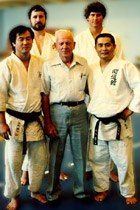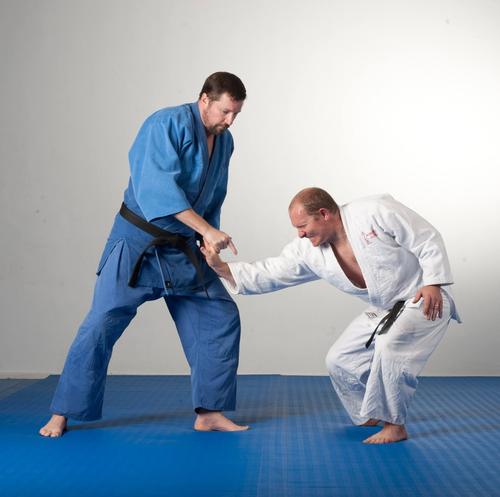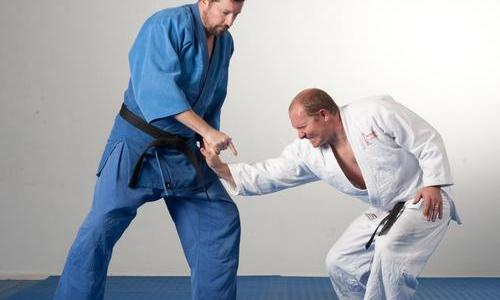Mark Barlow first met Alex Marshall during his time at university in a judo class. Barlow joined the class and never looked back. As Marshall began working with more and more law enforcement, he started to codify everything that he learned into one system, Akayama-ryu Jujutsu. Since his passing, Barlow has taken over the responsibilities of leader of the ryu. Today, Barlow talks about his training under Marshall and where Akayama-ryu will go in the future. All images provided by Mark Barlow.
Martial Arts of Yesterday, Today, and Tomorrow: Welcome Barlow Sensei! Thank you for joining us today!
Mark Barlow: Thank you for having me.
MAYTT: How did you come to find Akayama-ryu and Alex Marshall? What was it about both the art and the founder that made you continue training?

MB: Mr. Marshall was teaching a judo class at a local college. I enrolled as a freshman in the Fall of 1976 and visited the campus during the Summer session to get familiar with the layout. Walking through the gym, I stopped to watch the judo class. Mr. Marshall noticed me and told me to kick my shoes and socks off and join them. Forty-seven years later and I’ve never left the tatami.
I’m 6’4” and was in decent shape when I first met Mr. Marshall. He was in his mid-sixties and just under 5’5”. The ease with which he tossed me around was the initial hook that initially made me want to learn. Later, after he invited me to join a Saturday workout he held for a handful of students where he taught jujutsu, I was really hooked.
MAYTT: In what ways would you describe the training you experienced under Marshall? In what ways have you seen Akayama-ryu training change and evolve since you started?
MB: Mr. Marshall taught Defensive Tactics at the Birmingham Police Academy for over twenty years and his only criteria for martial arts training and instruction was is it practical in most situations and for the majority of practitioners? Having to prepare a diverse group of police cadets with varied physical abilities in a short time to defend themselves and others in often life and death situations carried over to his jujutsu classes. Practicality was first and foremost and that hasn’t changed since his passing.
MAYTT: Could you tell us a little bit more about Marshall and how he came to establish his own style and interpretation of jujutsu that is Akayama-ryu?
MB: Born in 1907, Mr. Marshall began boxing in his teens. When he attended Auburn, he studied fencing and the lance used from horseback. After graduating, he accepted a job in Chicago and was able to join a judo dojo. Over the next few decades, he also trained in jujutsu and Tomiki Aikido. He earned dan rank in judo, aikido, and multiple styles of jujutsu.
In 1988, he decided to codify the jujutsu he taught and named Richard Worthington and me as the senior students and instructors. Acknowledging the overlap of jujutsu techniques and those from judo and aikido, he chose to use the more common terminology from judo and aikido rather than the often flowery but non-descriptive names often used in traditional jujutsu.
I should note that not referring to Mr. Marshall as Sensei is not intended in any way to denigrate him. He eschewed any title or honorific and if addressed as Sensei, would just tell the person to call him Alex.
MAYTT: I see. With whom did Marshall train judo and aikido under? From your recollection, how influential was judo and aikido to the creation of Akayama-ryu as opposed to the other jujutsu styles he trained?
MB: I know there are some instructors I have forgotten or weren’t aware of, but Mr. Marshall always said his primary judo and jujutsu instructors were Shogen Okabayashi Sensei, Fumiaki Shishido Sensei, and Toshiaki Takikawa Sensei. Okabayashi Sensei taught Shinin-ryu and Takikawa Sensei taught and ranked Mr. Marshall, Worthington and me in Jikishinkage-ryu Jujutsu. The Jikishinkage-ryu we learned was not related to either the kenjutsu or naginatajutsu systems. According to Toshi, it is a very small system with a limited syllabus of jujutsu waza and four or five weapon kata.

Mr. Marshall studied under Karl Geis Sensei, Toshi Takikawa Sensei, and Tetsuro Nariyama, all Tomiki Aikido instructors. His ranks were godan in aikido and judo, rokudan in Jikishinkage-ryu and hachidan in Akayama-ryu Jujutsu. I know he had dan rank in Shinin-ryu but I’m not sure what rank.
MAYTT: Where does Richard Worthington fit into the Akayama-ryu narrative?
MB: Richard Worthington and I trained together under Mr. Marshall. We were his senior students and the first ones ranked in Akayama-ryu. Worthington Sensei continues to teach and has a dojo in Trussville, Alabama. I do not currently have a dojo. I train and teach out of two dojo of students here on the Gulf Coast and circuit ride to visit as many dojo in the system as I can each year.
MAYTT: In your experience, what makes Akayama-ryu unique or different from its jujutsu brethren?
MB: Practicality. Akayama-ryu attracts many Law Enforcement Officers and we count among our yudansha several Defensive Tactics instructors on the local, state and federal level. I’ve been a guest instructor for SRT events and hear frequently from LEOs of the efficiency and brutal practicality of Akayama-ryu.
MAYTT: I can see how that makes the art unique. You also had a chance to train aikido under Karl Geis and Tetsuro Nariyama. What was it like training under these two instructors and how has aikido benefitted your understanding of Akayama-ryu?
MB: Geis Sensei was brilliant in his systematic approach to teaching. I don’t know of anyone who has his gift for breaking down a technique and conveying it to a group. On the other hand, this was too often overshadowed by personal conflict and temperamental outbursts on his part.
As far as demonstrating and helping a student fine tune a technique, I don’t think Nariyama Sensei has an equal. Having been on the receiving end of his throws, I can honestly say I’ve never been thrown harder or smoother. Along with his technical ability, Nariyama Sensei maintains such an obvious love of what he is doing that even the most strenuous sessions have a lighthearted atmosphere.
MAYTT: Additionally, you have experienced Seki-ryu Jujutsu, Jikishinkage-ryu Jujutsu, and judo, earning yudansha ranks in each respectively. How has these arts further exploration into jujutsu styles expanded your interpretation of Akayama-ryu?
MB: Each of the styles I’ve earned rank in have more similarities than differences. I like to say they are all in the same church, just different pews. Jikishinkage-ryu as taught by Toshi Takikawa Sensei offered a smaller syllabus with one signature kata. It included several techniques designed to be used against a sword or staff. Seki-ryu, shared by Skip Koepke Sensei, focused its weapon defense on knife attacks. Akayama-ryu does include the kata from Jikishinkage-ryu for both its historical context and for the fact that muto applies equally to machete or baseball bats, but most of our weapons defense relates to knife assaults.
No martial art today is created in a vacuum, and we acknowledge that Akayama-ryu owes much to systems that came before. While we may have tweaked techniques to fit modern needs, we readily give credit to past instructors and styles for unique variations we may show.

MAYTT: What are some of the plans that you or others within the ryu for the future? What do you think Akayama-ryu will look like in fifteen years?
MB: We host national camps twice a year and our yudansha represent Akayama-ryu at various camps and seminars across the country throughout the year. While the main focus of camps and seminars is to reinforce kihon waza for current students, it’s also a way to introduce Akayama-ryu to folks outside the system. Many of our black belts have come to us after training at a camp and experiencing both the camaraderie and simplicity/practicality that is the heart and soul of Akayama-ryu.
It is my hope that Akayama-ryu will continue to spread and the essence will remain self-defense. I believe that as long as the leadership maintains the proper attitude of respect for others, confidence in ourselves and a willingness to learn as well as share, Akayama-ryu will be around for generations to come.
MAYTT: Thank you again for joining us today, Barlow Sensei! This was a great conversation!
MB: Thank you for your interest in Akayama-ryu Jujutsu and for your support of the martial arts community.


